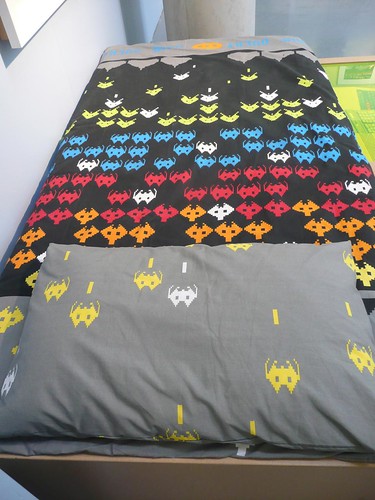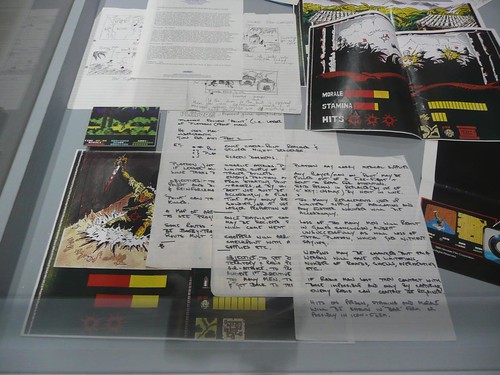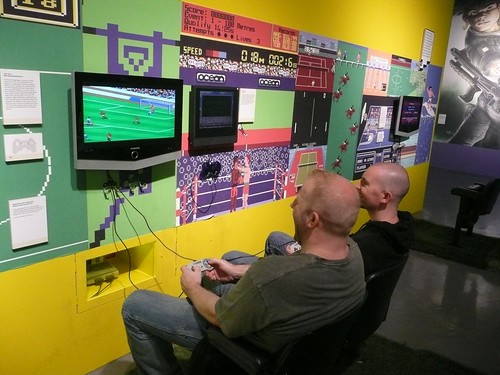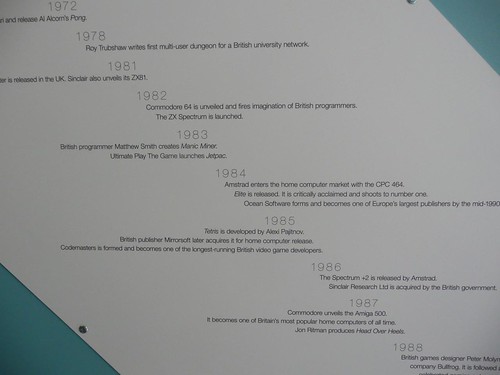Videogame Nation
(on from May 2009 until 19 September 2009, Urbis, Manchester, £3 admission)
(images are my own - please click for a larger version on Flickr)
As a fan of computer games and later on console games since I was a small lad, I've been in the lucky position of being in the generation that's grown up with the changes of technology and also to have the experience of playing everything from the old consoles such as the Atari 2600 to the modern day PS3s and Wiis of right now, and pretty much most things in between along the way. As the technlogy has changed, so has the culture and indeed the media opinions of what's now a multi million pound industry, where dog does indeed eat dog, and quite frequently too.
Videogame Nation is an attempt to try and sum up the history and genres of gaming in one relatively easy to swallow exhibition, and Urbis at Manchester was chosen partly because of the North West of England's role in games software - from the days of Ocean in Manchester to right now via TT Games in Knutsford, Cheshire, and pretty much a fair chunk in betwen all that. It meant that one of the larger spaces on the first floor could be used to good effect, and as that was where they had the excellent Factory Records exhibition some time ago, hopes were reasonably high that this could be carried off with aplomb.
First signs are promising, before you enter the exhibition you are presented with two large video screens, one showing the old 8-bit games and the other more modern offerings with a quote that claims that man is a gaming animal. A quote like that is fine in its context, but isn't it also a little bit sexist? What about the female gamers amongst the world? Once you pay your admission costs though, parity and some order is quite well restored with the first thing that you're presented is a typical gamer's bedroom. The racks that are shelves have plenty of cassette tapes of old games (mainly Ocean/Imagine ones it has to be said) and a mock up bed complete with Space Invaders inspired duvet cover and pillowcase, plus cabinets that appear to be from under the bed with plenty of stalwarts such as the Sinclair Spectrum, Commodore 64, Dragon 32 and so on.
On the opposite side of this room is a display which tries to settle the old playground Spectrum vs Commodore argument, and sort of succeeds in that it declares a draw. And then to the right of this room, let the gaming action commence. There's a feature on David Braben, the programmer of Elite, along with the game running. Alongside it is the original artwork for Jet Set Willy and the Spectrum version running, next to that is Lunar Jetman by Ultimate and its original artwork along with Ocean's excellent Head Over Heels via the Amstrad version, and at the end Monty on the Run, which runs the Spectrum version but mentions the trivia about the Commodore 64 soundtrack. Bit odd, that, you'd think that they'd be running the Commodore one.
It's at this point you see the major negative point of Videogame Nation, and certainly one that did upset me a fair bit. All the 8-bit computer games are in fact running not on original hardware but on emulators, and even worse, you're given possibly the worst PC joypads in gaming history to play them on. This in particular makes Head Over Heels frustrating (when it shouldn't be) and Lunar Jetman far less accurate in terms of ascending up wih the jet pack. I am sure that if the organisers wanted to encourage the people to play the games, it would have been a very nice touch to have at least have some of the original hardware to be able to offer an authentic game experience on.
Beyond all this is a section on top down racing games, which features Micro Machines on the Nintendo NES (original hardware used) and the not top down racer Burnin' Rubber on the ill-fated Amstrad GX4000 console. It did mention in its blurb about how the top down racing game made a different angle on the driving game, which was nice to see. Then there's the arcade and its conversions section - and for me an opportunity partly well executed but also partly missing out. There was an arcade cabinet with Ghosts and Goblins and the Commodore 64 conversion so you could try both out, and an arcade cabinet with Rainbow Islands, but no conversion! (The Commodore 64 one would have been perfect here). Also, since when was Imagine's "Target Renegade" an arcade conversion? Although having Operation Wolf on the Commodore 64 did at least try and balance it out a bit. And again, all the home computer versions are running - yes you guessed it - on emulators. Also note that you had to pay money to use the arcade machines - 50p in the case of Rainbow Islands!
After all this, you've got a section on racing games in three dimensions, which for me focuses far too much on modern day consoles. Sure, the likes of Ferrari F365 Challenge is good fun, but it would have been nice to show something good on say the Spectrum and then show development to what we have now. You've then got a bit of a confused display - one table stands empty apart from a PC running the likes of Populous, and side displays with some games, which makes you think it needs a little more in this room. And on the glass cabinet table, you'll find that bit extra.
Inside there, there's plenty of behind the scenes memorablia with regards to Ocean, one of the leading publishers of games back in the day and who were proudly based in Manchester. You've got some of their internal-only cartoon comics, you've got contracts between publishers and programmers, you've got storyboards to games like Vindicator and Platoon, you've also got a letter from Sensible Software to Ocean with regards to a near-finished version of Wizball, and on top of all that, press handouts and all that sort of thing. For me it was fascinating and certainly gave a real "behind the scenes" feel of making a game. For me, I wished there was more stuff like that, maybe coupled with the games to play next to those displays.
You then go through to the sports games section. One wall is littered with screen shots of sports games of the era along with the other wall having a huge screen shot of Codemasters' "Motocross". At the start of this room, there's a table with glass cabinet with plenty of background behind Sensible Software's football games and some good publicity shots which feature amongst others the late great Richard Joseph, who's still sadly missed even today. You also have the likes of the isometric versions of the FIFA franchise as well as Sensible world of Soccer, a good idea in my view. You could even sit on the former executive seats from Manchester City's old Maine Road ground whilst playing them, and on City's old astroturf to boot. Very neat, that, and apart from having Daley Thompson's Decathlon on the Amstrad emulated (imagine having to do joystick waggling on a joypad - rubbish!) it pretty much served its purpose well.
A bus shelter has a couple of handheld games and is a small nod to how handheld gaming became part of gaming culture, even mentioning Snake that came with some Nokia mobule phones as a perfect way to pass the time wonderfully well. Beyond this is a section on game characters, which features the developer TT Games and two of their Lego-based games including Lego Star Wars, running very nicely on their Playstation 3s, along with the Lego-based Motorstorm as well. The wall also gave a nod here to many famous gaming characters such as Lara Croft of Tomb Raider fame.
Behind this was an entrance to a blackened out room which had a large projector display, showing three television feasts. The first was a documentary shown on Channel 5 in 2008 about the making of the iconic BBC Micro game "Elite", and featured David Braben and Ian Bell. Peter Snow's excellent narration really did make you feel like the game was something special and deserved of all the looking back. That for me was good, as was an episode of the old show "Gamesmaster" shown afterwards, which tried to put gaming into the mainstream with the help of Dominik Diamond, but the programme in between those was even better.
"Commercial Breaks", shown on BBC2 in late 1984, showed you the planning to try and have the Christmas number one slot, and how Imagine went from making money to losing it, gambling everything on mega-game Bandersnatch, and not realising the financial implications till way too late. In contrast, David Ward's leadership of Ocean was much more professional, and the tight ship there meant that their games were able to make it to market and in good time. One revealing bit was where the BBC took Ward to a market near Manchester and he was able to pick up illegally copied games that were hard to distinguish from the original tape. It was fascinating and brilliantly made stuff for its time, and seeing the bailiffs move into Imagine must have been something that the documentary makers had no idea of it happening but must have been a "you had to be there" moment for them - certainly capturing the flavour of its era excellently. It's worth going to see all three alone, which is what I did - watched them all back to back.
After this is a small section for over 18s only about games censorship and how controversial titles were made to be hyped up in all the media frenzy. And yet no nod to the likes of CRL's "Dracula" and "Frankenstein" circa 1987 where the text was descriptively gory and some of the graphics bloody, which prompted CRL to get BBFC classification for their games in order to ensure they weren't sold to underage gamers. But of course the likes of Bully and Hitman 2 certainly do make for interesting debate amongst those who feel that it breeds violence to those who dismiss it as "just a a bit of fun".
Walking around to the end now past Little Big Planet on the Playstation 3 and one of the WiiWare games on the Wii, and there's a descriptive timeline of some of the moments to happen in computer and video gaming, with suitable nods to some of the games that are featured in the exhibition itself, notably also when the Spectrum and Commodore 64 were released as well as other milestones for some of the important consoles later on in the timeline. It was well written on the whole and impossible to get every major description in, so good to see that too, and at the end you could write your memories and place it on a wall next to some of the consoles and computers of your choice, which some people chose to do - it worked pretty well on the whole, I think.
So overall, is it worth going, I hear you ask? Well for three quid, you do get quite a potted history of games and certainly plenty of good information and trivia, and some of the behind the scenes memorabilia is fascinating stuff to have a look at to understand the development of games and how it took so much time and planning even back then. The documentaries shown on the large screen are also well worth a watch, and some of the games on the consoles at least are classics of their time. However, I just wish that the 8-bit games were played using the original equipment and not emulators with appallingly bad joypads. I did find this a major letdown that an exhibition supposedly celebrating gaming wasn't remaining faithful to its original origins, and if something similar is hosted again, that would need to be rectified.
I might be nitpicking, but on the positive, there are some fascinating sights and sound as well as informative descriptions of the games, the software companies and indeed the whole ethos of the industry in there. I spent three hours including watching the video footage, so it's worth a good half a day of your time to have a look around and take everything in. And it does show some promise even if it's not as important an exhibition as, say, Game On was back at the Barbican in 2002. Have a look for yourself at Videogame Nation, and enjoy it - I did despite its faults.
Warren's rating: 74%





